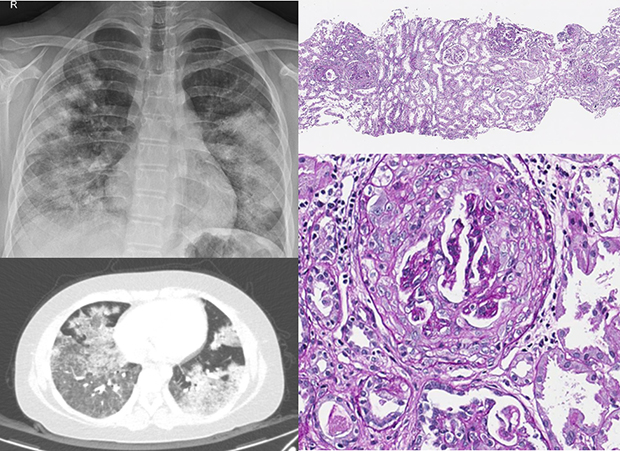1. Hutton HL, Holdsworth SR, Kitching AR. ANCA-associated vasculitis: pathogenesis, models, and preclinical testing. Semin Nephrol. 2017; 37(5):418–435.

2. Hogan JJ, Markowitz GS, Radhakrishnan J. Drug-induced glomerular disease: immune-mediated injury. Clin J Am Soc Nephrol. 2015; 10(7):1300–1310.

3. Banfi G, Imbasciati E, Guerra L, Mihatsch MJ, Ponticelli C. Extracapillary glomerulonephritis with necrotizing vasculitis in D-penicillamine-treated rheumatoid arthritis. Nephron. 1983; 33(1):56–60.
4. Sadjadi SA, Seelig MS, Berger AR, Milstoc M. Rapidly progressive glomerulonephritis in a patient with rheumatoid arthritis during treatment with high-dosage D-penicillamine. Am J Nephrol. 1985; 5(3):212–216.
5. Williams AJ, Fordham JN, Barnes CG, Goodwin FJ. Progressive proliferative glomerulonephritis in a patient with rheumatoid arthritis treated with D-penicillamine. Ann Rheum Dis. 1986; 45(1):82–84.

6. Devogelaer JP, Pirson Y, Vandenbroucke JM, Cosyns JP, Brichard S, Nagant de Deuxchaisnes C. D-penicillamine induced crescentic glomerulonephritis: report and review of the literature. J Rheumatol. 1987; 14(5):1036–1041.
7. Mathieson PW, Peat DS, Short A, Watts RA. Coexistent membranous nephropathy and ANCA-positive crescentic glomerulonephritis in association with penicillamine. Nephrol Dial Transplant. 1996; 11(5):863–866.

8. Hillis GS, Khan IH, Simpson JG, Rees AJ. Scleroderma, D-penicillamine treatment, and progressive renal failure associated with positive antimyeloperoxidase antineutrophil cytoplasmic antibodies. Am J Kidney Dis. 1997; 30(2):279–281.

9. Karpinski J, Jothy S, Radoux V, Levy M, Baran D. D-penicillamine-induced crescentic glomerulonephritis and antimyeloperoxidase antibodies in a patient with scleroderma. Am J Nephrol. 1997; 17(6):528–532.
10. Nanke Y, Akama H, Terai C, Kamatani N. Rapidly progressive glomerulonephritis with D-penicillamine. Am J Med Sci. 2000; 320(6):398–402.

11. Bienaimé F, Clerbaux G, Plaisier E, Mougenot B, Ronco P, Rougier JP. D-Penicillamine-induced ANCA-associated crescentic glomerulonephritis in Wilson disease. Am J Kidney Dis. 2007; 50(5):821–825.

12. Gibson T, Burry HC, Ogg C. Letter: Goodpasture syndrome and D-penicillamine. Ann Intern Med. 1976; 84(1):100.
13. Gavaghan TE, McNaught PJ, Ralston M, Hayes JM. Penicillamine-induced “Goodpasture's syndrome”: successful treatment of a fulminant case. Aust N Z J Med. 1981; 11(3):261–265.
14. Peces R, Riera JR, Arboleya LR, López-Larrea C, Alvarez J. Goodpasture's syndrome in a patient receiving penicillamine and carbimazole. Nephron. 1987; 45(4):316–320.

15. Macarrón P, García Díaz JE, Azofra JA, Martín de Francisco J, Gonzalez E, Fernandez G, et al. D-penicillamine therapy associated with rapidly progressive glomerulonephritis. Nephrol Dial Transplant. 1992; 7(2):161–164.

16. Endo H, Hosono T, Kondo H. Antineutrophil cytoplasmic autoantibodies in 6 patients with renal failure and systemic sclerosis. J Rheumatol. 1994; 21(5):864–870.
17. Gaskin G, Thompson EM, Pusey CD. Goodpasture-like syndrome associated with anti-myeloperoxidase antibodies following penicillamine treatment. Nephrol Dial Transplant. 1995; 10(10):1925–1928.
18. Derk CT, Jimenez SA. Goodpasture-like syndrome induced by D-penicillamine in a patient with systemic sclerosis: report and review of the literature. J Rheumatol. 2003; 30(7):1616–1620.
19. Sternlieb I, Bennett B, Scheinberg IH. D-penicillamine induced Goodpasture's syndrome in Wilson's disease. Ann Intern Med. 1975; 82(5):673–676.

20. Ntoso KA, Tomaszewski JE, Jimenez SA, Neilson EG. Penicillamine-induced rapidly progressive glomerulonephritis in patients with progressive systemic sclerosis: successful treatment of two patients and a review of the literature. Am J Kidney Dis. 1986; 8(3):159–163.

21. Lee Y, Lee ST, Cho H. D-penicillamine-induced ANA (+) ANCA (+) vasculitis in pediatric patients with Wilson's disease. Clin Nephrol. 2016; 85(5):296–300.

22. Choi HK, Merkel PA, Walker AM, Niles JL. Drug-associated antineutrophil cytoplasmic antibody-positive vasculitis: prevalence among patients with high titers of antimyeloperoxidase antibodies. Arthritis Rheum. 2000; 43(2):405–413.

23. West SC, Arulkumaran N, Ind PW, Pusey CD. Pulmonary-renal syndrome: a life threatening but treatable condition. Postgrad Med J. 2013; 89(1051):274–283.

24. Lee RW, D'Cruz DP. Pulmonary renal vasculitis syndromes. Autoimmun Rev. 2010; 9(10):657–660.

25. Matloff DS, Kaplan MM. D-Penicillamine-induced Goodpasture's-like syndrome in primary biliary cirrhosis--successful treatment with plasmapheresis and immunosuppressives. Gastroenterology. 1980; 78(5 Pt 1):1046–1049.

26. McAdoo SP, Tanna A, Randone O, Tam FW, Tarzi RM, Levy JB, et al. Necrotizing and crescentic glomerulonephritis presenting with preserved renal function in patients with underlying multisystem autoimmune disease: a retrospective case series. Rheumatology (Oxford). 2015; 54(6):1025–1032.

27. O'Sullivan KM, Lo CY, Summers SA, Elgass KD, McMillan PJ, Longano A, et al. Renal participation of myeloperoxidase in antineutrophil cytoplasmic antibody (ANCA)-associated glomerulonephritis. Kidney Int. 2015; 88(5):1030–1046.
28. Radić M, Martinović Kaliterna D, Radić J. Drug-induced vasculitis: a clinical and pathological review. Neth J Med. 2012; 70(1):12–17.
29. Li J, Uetrecht JP. D-penicillamine-induced autoimmunity: relationship to macrophage activation. Chem Res Toxicol. 2009; 22(9):1526–1533.

30. Li J, Mannargudi B, Uetrecht JP. Covalent binding of penicillamine to macrophages: implications for penicillamine-induced autoimmunity. Chem Res Toxicol. 2009; 22(7):1277–1284.

31. Jiang X, Khursigara G, Rubin RL. Transformation of lupus-inducing drugs to cytotoxic products by activated neutrophils. Science. 1994; 266(5186):810–813.

32. Nakazawa D, Tomaru U, Suzuki A, Masuda S, Hasegawa R, Kobayashi T, et al. Abnormal conformation and impaired degradation of propylthiouracil-induced neutrophil extracellular traps: implications of disordered neutrophil extracellular traps in a rat model of myeloperoxidase antineutrophil cytoplasmic antibody-associated vasculitis. Arthritis Rheum. 2012; 64(11):3779–3787.
33. Yokogawa N, Vivino FB. Hydralazine-induced autoimmune disease: comparison to idiopathic lupus and ANCA-positive vasculitis. Mod Rheumatol. 2009; 19(3):338–347.

34. Grau RG. Drug-induced vasculitis: new insights and a changing lineup of suspects. Curr Rheumatol Rep. 2015; 17(12):71.

35. Yang J, Yao LP, Dong MJ, Xu Q, Zhang J, Weng WW, et al. Clinical characteristics and outcomes of propylthiouracil-induced antineutrophil cytoplasmic antibody-associated vasculitis in patients with Graves' disease: a median 38-month retrospective cohort study from a single institution in China. Thyroid. 2017; 27(12):1469–1474.







 PDF
PDF Citation
Citation Print
Print




 XML Download
XML Download